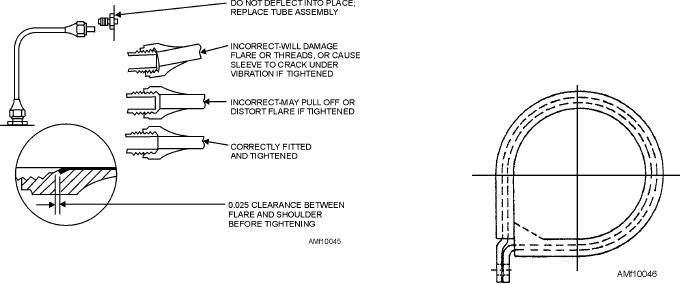
If an aluminum alloy flared tube assembly leaks
installed. Before you install tube assemblies, check to
after it has been tightened to the required torque,
make sure there are no dents, nicks, and scratches; that
disassemble it for repair or replacement. If a steel flared
the assembly contains the correct nuts and sleeves; that
tube assembly leaks, it may be tightened one-sixteenth
there is a proper fit, where fitting is flared; that a proof
turn beyond the noted torque. If the assembly continues
pressure test is performed on each assembly; and that
to leak, it should be disassembled for repair or
the assemblies are clean.
replacement. Do not tighten a nut when there is
To install tube assemblies, hand screw the nuts onto
pressure in the line. Do not overtighten a leaking
mating connectors. Align the tube assembly in place so
aluminum alloy assembly. Overtightening may
that it will not be necessary to pull it into place with the
severely damage or cut off tubing flare, or damage
nut. Tubing that runs through cutouts should be
sleeve or nut.
installed to avoid scarring when the tubing is worked
When you install flareless tube assemblies,
through a hole. If the tube assembly is long, tape the
proceed as follows: Make sure no nicks or scratches are
edge of cutouts before installing the assembly. Torque
evident and the sleeve is preset. Tighten the nut by hand
the nuts. Apply a protective coating to the remaining
until resistance to turning develops. If it is impossible to
nonsealed joints after tubing is installed. For
use fingers to run nut down, use a wrench. Look out for
disconnected nonsealed joints, apply MIL-S-8802,
the first signs of bottoming. Do not use pliers to tighten
followed by appropriate paint system, if required. For
tube connectors.
connected nonsealed joints, apply the first coat of
MIL-C-16173, grade 4; 1 hour after applying the first
Final tightening should begin at the point where the
coat, apply the second coat of MIL-C-16173, grade 4.
nut begins to bottom. Use a torque wrench if fitting is
Correct and incorrect methods of installing flared tube
accessible and torque fitting. If a connection is not
assemblies are shown in figure 10-45.
accessible for torque wrench, use a wrench to turn nut
one-sixth turn while holding the connector with another
Leakage of a flared tube assembly is usually caused
wrench to prevent the connector from turning. A
by the following:
one-sixth turn equals the travel of one flat on a hex nut.
Flare distorted into the nut threads.
Tighten nut an additional one-sixth turn if the connector
Sleeve cracked.
leaks. Do not tighten fitting nut more than one-third of a
turn (two flats on nuts). Loosen and completely
Flare out of round.
disconnect the nut if the leak continues. Inspect fitting
components for scores, cracks, foreign material, or
Flare cracked or split.
damage from previous overtightening. Reassemble
Inside of flare rough or scratched.
fitting. Fingertighten nut and repeat wrench tightening.
It is important to tighten tube fitting nuts properly. A
Connector mating surface rough or scratched.
fitting wrench or an open-end wrench should be used
Connector threads or nuts are dirty, damaged, or
when tightening connections.
broken.
All hydraulic tubing should be supported from
rigid structures by cushioned steel clamps
MIL-C-85052 or multiple tube block clamps. See
figure 10-46. Hydraulic tubing support clamps should
be installed and maintained in the positions described
in the MIM or applicable technical directives.
Figure 10-45.--Correct and incorrect methods of installing
flared fittings.
Figure 10-46.--Cushioned steel clamps MIL-C-85052.
10-42

